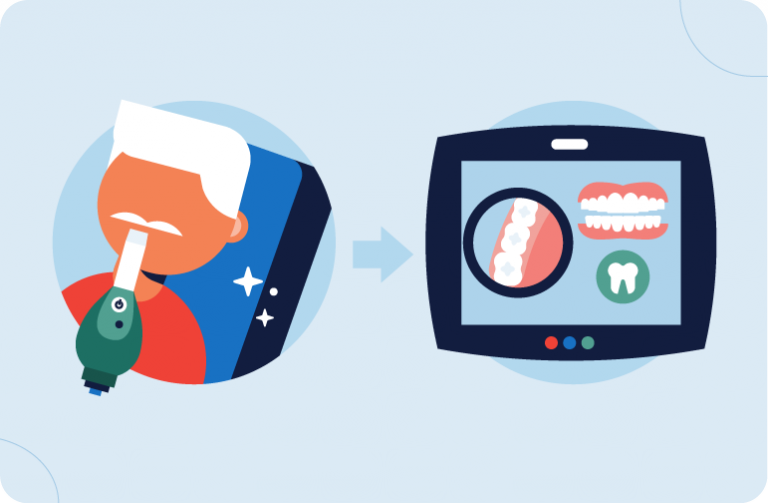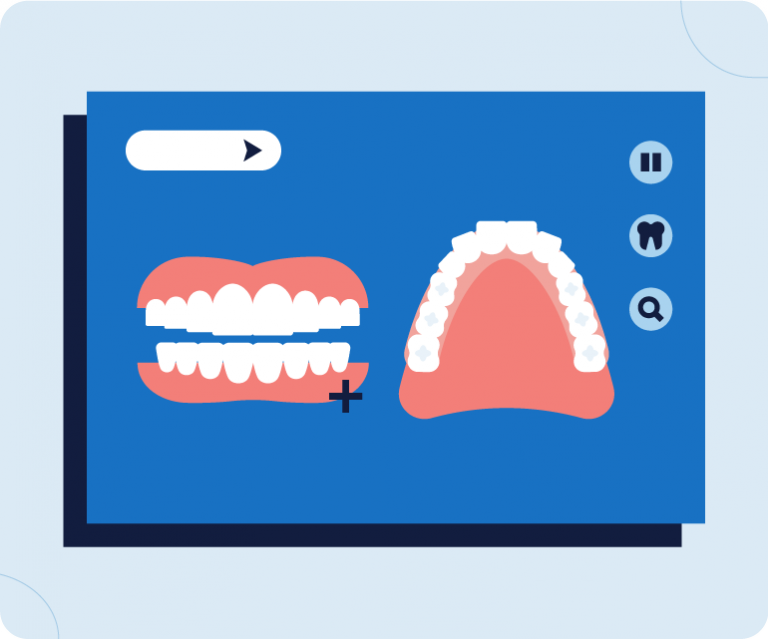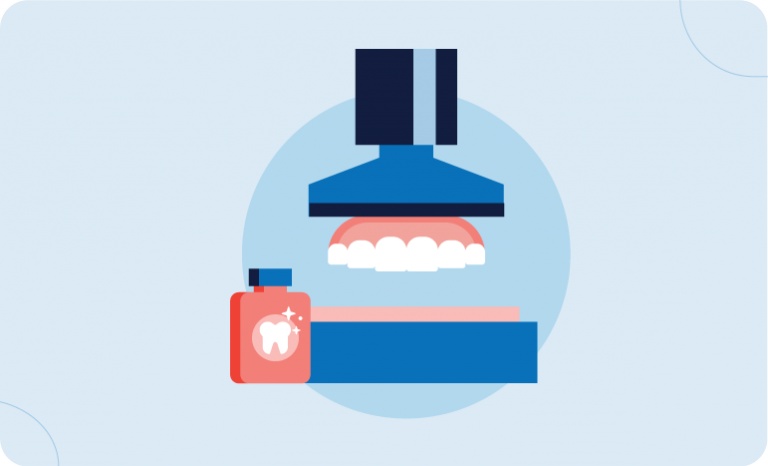Digital Dentures: Advanced Technology for Your Mouth
Digital dentures are growing in popularity due to their quick turnaround time, comfortable fit and financial benefits. Understanding this technology can help you know if it’s the right option for you.

- Edited By
Savannah Pittle

Savannah Pittle
Senior Financial Editor
Savannah Pittle is a professional writer and content editor with over 16 years of professional experience across multiple industries. She has ghostwritten for entrepreneurs and industry leaders and been published in mediums such as The Huffington Post, Southern Living and Interior Appeal Magazine.
Read More- Published: May 18, 2022
- Updated: May 23, 2023
- 8 min read time
- This page features 11 Cited Research Articles
Do you know someone who has traveled abroad for dental work? Many Americans participate in this practice to stretch their financial resources as far as they can. However, it isn’t always necessary.
Dental work in the United States has become increasingly advanced in the last two decades, allowing for prosthetics like digital dentures to become more readily available. These 3D-printed artificial teeth are often more durable and comfortable than traditional dentures, giving you the greatest value for your money without ever needing to leave the country.
If you’ve decided to move forward with getting dentures instead of implants or another prosthesis, continue reading to find out the specific benefits of digital dentures over traditional ones.
What Are Digital Dentures?
Digital dentures are made with advanced computer programming technology, compared to traditional dentures made using molds of your mouth. According to research on PubMed Central, dentures made with digital technology have been around for over 20 years and have only evolved in that time.
You may hear the terms “3D-printed dentures” or “3D dentures.” This is because digital dentures are typically made using a 3D printer, providing unique benefits compared to traditional dentures.
How Are Digital Dentures Made?
3D dentures are made by taking a digital scan of your mouth and then using a hard resin to print the dentures with a 3D printer. Because the scans of your mouth are digital, your dental care provider can keep them in your record in case you need a replacement after losing your dentures or breaking them (although breaking or chipping digitally made dentures can prove difficult).
Look through the steps below to gain a better understanding of the process for making digital dentures.
Step 1: Mouth Scans
The first step to making 3D-printed dentures requires a dental professional to take a series of scans of your mouth. Unlike molds for traditional dentures, these digital scans are able to more accurately map contours along the gums, allowing for better fitting dentures and a more comfortable experience.

Because this digital imagery is so efficient and precise, this is one of only a few dental appointments necessary to get your digital dentures.
Step 2: Scans Sent to the Lab
Once the scans of your mouth are complete, your dental professional will review them for completeness. In some cases, they may need to take additional scans to ensure the dentures perfectly fit the anatomy of your mouth.

Before beginning the printing process, your dental professional will mark key points along the anatomy of your mouth, such as the location of your front teeth and where your molars end. This ensures your dentures will align with your jaw as your original teeth would, providing maximized comfort.
Some dental professionals will also provide you with a second appointment to try on the denture mold created from your scans. This allows you to test for comfort and functionality and make any tweaks before starting the process to create your real dentures.
Step 3: 3D Printing Begins
Once approved, the dentures are then printed in a 3D printing machine that pulls the scans from your mouth to create custom dentures.

After the dentures have been printed, they are then finalized with a highly durable coating and thoroughly sanitized. After curing, you’ll be able to try on the final product.
Digital Dentures Cost
The cost of digital dentures can be complex because it greatly depends on where you live and what your individual dental care provider chooses to charge. Typically, 3D-printed dentures can be more affordable and provide a higher value since they’re more comfortable and durable. To find out what your dental provider charges, give them a call or visit their website.
If you currently have dental coverage through a private insurer, they may help cover the cost of this service. However, Original Medicare typically will not help cover dentures. Select Medicare Advantage or Medigap plans may cover portions, so make sure to ask your Medicare advisor what is and isn’t included in your plan.
Advances in Dentures
The technology behind digital dentures began in the early 1970s and has evolved greatly over time. In 1973, the idea to use computer-aided design/computer-aided manufacturing (CAD/CAM) in dentistry was first introduced. However, the first 3D printer wasn’t released to the open market until 1987, and other technology was required before 3D-printed dentures could be made.
In 2006, Align Technology, Inc. created the iTero scanner that could digitally map the anatomy of a patient’s mouth. In 2015, digital scanning technology and 3D printing technology combined to create the first digital denture. Since then, the technology has continued to expand and become more reliable for both dental professionals and their patients.
Digital Dentures vs. Conventional Dentures
From the materials used to how each is produced, digitally made and traditionally made artificial teeth differ in many ways. Understanding the pros and cons of digital dentures vs. conventional dentures can aid you in making a decision that will be best for your situation.
Materials and Durability
Traditional dentures are often made of acrylic and sometimes porcelain, both of which can wear down and become distorted. Comparatively, the resin used to produce digital dentures is longer-lasting and isn’t as fragile or prone to discoloration. If you were to drop traditional dentures, they’d also likely break or chip, whereas digital dentures typically won’t.
Production Process
The process of making digital dentures is often much quicker than conventional dentures. To produce digital dentures, a dental professional will first take thorough scans of a patient’s mouth, which are then sent to a lab or directly to a 3D printer (depending on the technology available at the dental clinic). Once printed, the dentures undergo a series of treatments to cure and finalize the look.
Traditional dentures (depending on whether they’re full or partial) require a series of fittings and molds. Once the impressions are made, they’re placed in a special machine to attach the artificial teeth. After this point, the molds go through a variety of different processes to make the finished product. Obtaining traditional dentures can take up to three months, according to Denture Health Care, whereas 3D-printed dentures can be completed in a manner of weeks.
Value
Because digital dentures use a sturdier material, take a shorter amount of time to produce and often require fewer dentist visits than traditional dentures, they’re typically a better value for your money.
Fit
Digital scans are more precise in mapping contours and gum anatomy compared to traditional impressions, making 3D-printed dentures fit more comfortably. Additionally, the sturdy resin used to make digital dentures doesn’t warp as some traditional dentures do, thus preserving the shape and contouring found in the original scans.
Maintenance
According to Innovative Family Dentistry, 3D-printed dentures typically don’t build up bacteria and are easier to clean and maintain compared to traditional dentures.
Where Can You Get Digital Dentures?
Some dental professionals offer to produce digital dentures in-house if they have the proper equipment and training. Other times, they’ll offer to do the scans (again, if the equipment is available to them), and send the scans to a partnering lab to produce the dentures.
Before making an appointment with your dental care provider, ask them if they are able to make 3D-printed dentures. If not — and if you’d prefer digital dentures — consider looking elsewhere for this service.
Frequently Asked Questions
Still not sure if digital or traditional dentures are right for you? Here are some additional details that can help you make a decision for your dental health.
Digital dentures are a great prosthesis option for anyone looking to enhance their smile and be comfortable in the process. Before getting started, talk with a Medicare advisor and different dental professionals to understand payment options and costs.
Additionally, remember to use your medical binder to keep track of your dentist appointments and any specific instructions your dental provider gives you.
11 Cited Research Articles
- Bell, J. (2021, December 9). Digital Dentures Make Your New Teeth Better. Retrieved from https://innovativefamilydentistry.com/digital-dentures-make-your-new-teeth-better/
- Bencharit, S., Clark, W., Stoner, L., Chian, G., Sulaiman, T. (2021, November, 25). Recent Advancements in CAD/CAM Same-Day Dentistry in Practice and Education. Retrieved from https://www.preprints.org/manuscript/202111.0490/v1
- Turney, D. (2021, August 31). History of 3D Printing: It’s Older Than You Think. Retrieved from
- https://redshift.autodesk.com/articles/history-of-3d-printing
- Anadioti, E., Musharbash, L., Blatz, M. B., Papavasiliou, G., & Kamposiora, P. (2020). 3D printed complete removable dental prostheses: A narrative review. Retrieved from https://www.ncbi.nlm.nih.gov/pmc/articles/PMC7694312/
- Jason Harvey, DMD. (2017, August 30). The History of the CEREC System. Retrieved from https://drjasonharvey.ca/the-history-of-the-cerec-system/
- Hsuan. (2017, June 30). A Unique Approach to Intraoral Scanning. Retrieved from https://www.cerecdigest.net/2017/06/30/unique-approach-intraoral-scanning/
- Clock House Dentistry. (n.d.). Ceramic Fillings, With CEREC. Retrieved from https://www.clockhousedentistry.co.uk/dental-treatments/cerec/
- Denture Health Care. (n.d.). How Long Does It Take to Make Dentures – The Process: Start to Finish. Retrieved from
- https://denturehealthcare.com.au/how-long-does-it-take-to-make-dentures/
- 3Shape. (n.d.). Our Story. Retrieved from https://www.3shape.com/en/our-story
Calling this number connects you to one of our trusted partners.
If you're interested in help navigating your options, a representative will provide you with a free, no-obligation consultation.
Our partners are committed to excellent customer service. They can match you with a qualified professional for your unique objectives.
We/Our Partners do not offer every plan available in your area. Any information provided is limited to those plans offered in your area. Please contact Medicare.gov or 1-800-MEDICARE to get information on all of your options.
844-359-1705
